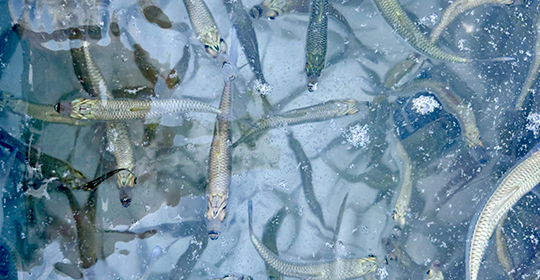Conserving Baitfish: Why Sustainable Practices Matter
By Debbie Hanson
Nov 20, 2024
You may be concerned with conservation practices as they pertain to your favorite sportfish species, but how often do you think about conserving baitfish? Creating awareness about conserving baitfish populations in our marine ecosystems is critical because baitfish species, such as anchovies, sardines, herring, and shad, are keystone food sources for larger predatory fish, seabirds, and marine mammals.
Sustainable baitfish practices help to conserve these important links in the marine food chains and ensure the health of our aquatic ecosystems.

Impacts of Declining Baitfish Populations
Commercially, baitfish are often processed for use in fishmeal and fish oil, which is provided to the aquaculture and livestock farming industries. They are also harvested in large numbers for use as recreational fishing bait. Given this widespread use, baitfish populations are often vulnerable to overfishing, habitat destruction, and environmental changes like ocean warming and acidification.
The depletion of baitfish reduces food availability for larger predatory fish species such as tuna, salmon, and cod. Marine birds and mammals that depend on baitfish for sustenance can also face population declines, leading to biodiversity loss. These cascading effects highlight the importance of managing baitfish populations in a sustainable manner.
Applying Sustainable Baitfish Practices
Sustainable baitfish practices include limiting the capture of wild baitfish to levels that do not deplete natural populations, using hatcheries to cultivate baitfish, and ensuring minimal bycatch of non-target species. It’s also crucial to consider the health of aquatic ecosystems by protecting water quality and habitats from degradation.
Implementing these measures can help to support biodiversity and maintain the balance of ecosystems that rely on baitfish as a keystone food source for larger species.
Regulated Harvesting
Governments and fisheries management organizations play a pivotal role in ensuring that baitfish populations are not overexploited. Implementing catch limits and applying gear restrictions are essential for sustainable management. This ensures that enough baitfish are left in our oceans to maintain healthy ecosystems.
Sustainable Fishing Gear
To reduce bycatch and minimize ecological disruption, anglers should use sustainable fishing gear. For example, nets and traps that allow smaller, juvenile baitfish to escape can prevent overharvesting and bycatch of younger fish, ensuring they have the chance to mature and reproduce (contributing to baitfish sustainability).
Habitat Protection
The marine habitats where baitfish spawn, such as estuaries and coastal areas, are often vulnerable to pollution, development, and climate change. Protecting and restoring these critical habitats is essential for baitfish conservation. Initiatives such as establishing marine protected areas (MPAs) and reducing coastal pollution can help preserve the environments necessary for baitfish to thrive.
Consumer Awareness
Anglers and consumers should be aware of the source of their baitfish. By choosing sustainably harvested baitfish or alternative options, you can reduce the demand for overexploited species. For example, many anglers on the Space Coast of Florida have witnessed declining stocks of Menhaden over the past few decades. When you support fisheries that follow sustainable practices, it sends a powerful message to the industry, encouraging more responsible approaches to baitfish management.
By conserving baitfish and adopting sustainable practices, including regulated harvesting, selective fishing gear, habitat protection, and increasing awareness, we can ensure that these links in the marine food chain remain intact. Conservation of baitfish is not only vital for maintaining ecological balance but also for preserving the future of fishing industries that rely on thriving fish populations.









